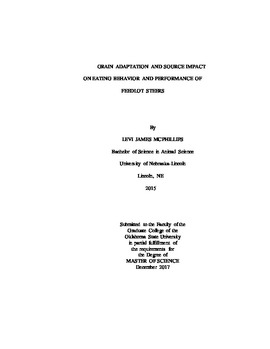| dc.description.abstract | A feedlot experiment was conducted to evaluate the effect of replacing steam-processed corn (SPC) with steam-flaked wheat (SFW) in feedlot rations. In experiment 1, 152 crossbred steers (321 ± 2.7 kg BW) were blocked by weight and randomly assigned to 1 of 4 treatments with 8 pens per treatment. Treatments contained varying levels of SFW (0, 20, 40, 60; CON, SFW20, SFW40, SFW60) were fed for 175d. All diets contained DDGS 20% of diet DM. In experiment 2, 6 ruminally cannulated steers (BW 395 ± 12 kg) were used to determine the in situ DM digestibility (ISDMD) of a fresh sample of: 1) dry-rolled corn (DRC); 2) SFW obtained immediately after flaking (SFW-F); 3) SFW obtained after drying through a vacuum air lift (SFW-D); 4) steam-flaked corn (SFC) obtained from a commercial feed yard (SFC); 5) composited sample of SPC fed throughout Exp. 1 (SPC). In Exp. 1 no differences in BW (P = 0.74) or ADG (P = 0.45) were observed. SFW60 had the lowest DMI (P = 0.05). A positive linear relationship in G:F (P = 0.03), YG (P = 0.01) and wheat inclusion. Cost of gain can be maintained if wheat price/27 kg is $0.18 to $0.76 greater than 25 kg of corn. In Exp. 2 there was no difference between SFW-E and and SFW-F (P = 0.99) and SFP had lower ISDMD than SFC at all time points (P < 0.01). Steam-flaked wheat can effectively be fed to feedlot cattle, but further research is needed to determine optimum dietary inclusion and when SFW is competitively priced to SPC. Two hundred and twenty-three steers (initial BW= 556.5 ± 4.2 kg) were adapted to an 90.75% concentrate diet using 4 diets to analyze feeding behavior during adaptation to a finishing diet in both winter and summer. Four step diets contained 22.3, 34.8, 42.8, 49.8, and 57.5% DRC, DM basis. Diet volume, energy, and DMI were calculated per meal and per d. Dry matter intake was greatest in FIN (P < 0.0001), and energy intake per d was greatest in FIN (P < 0.0001). Energy intake per meal was greatest in STEP4 and FIN (P < 0.0001). Increase in eating rate was likely due to less ensalivation needed in low forage diets. Data suggests that cattle consumed to physical fill in STEP1 and STEP2 and consumed to chemostatic fill in STEP3, STEP4 and FIN. Previous water restriction, animal size (> 550 kg), and previous nutrition (54.8% wet corn gluten feed for 160d) may have increased caloric capacity. | |
